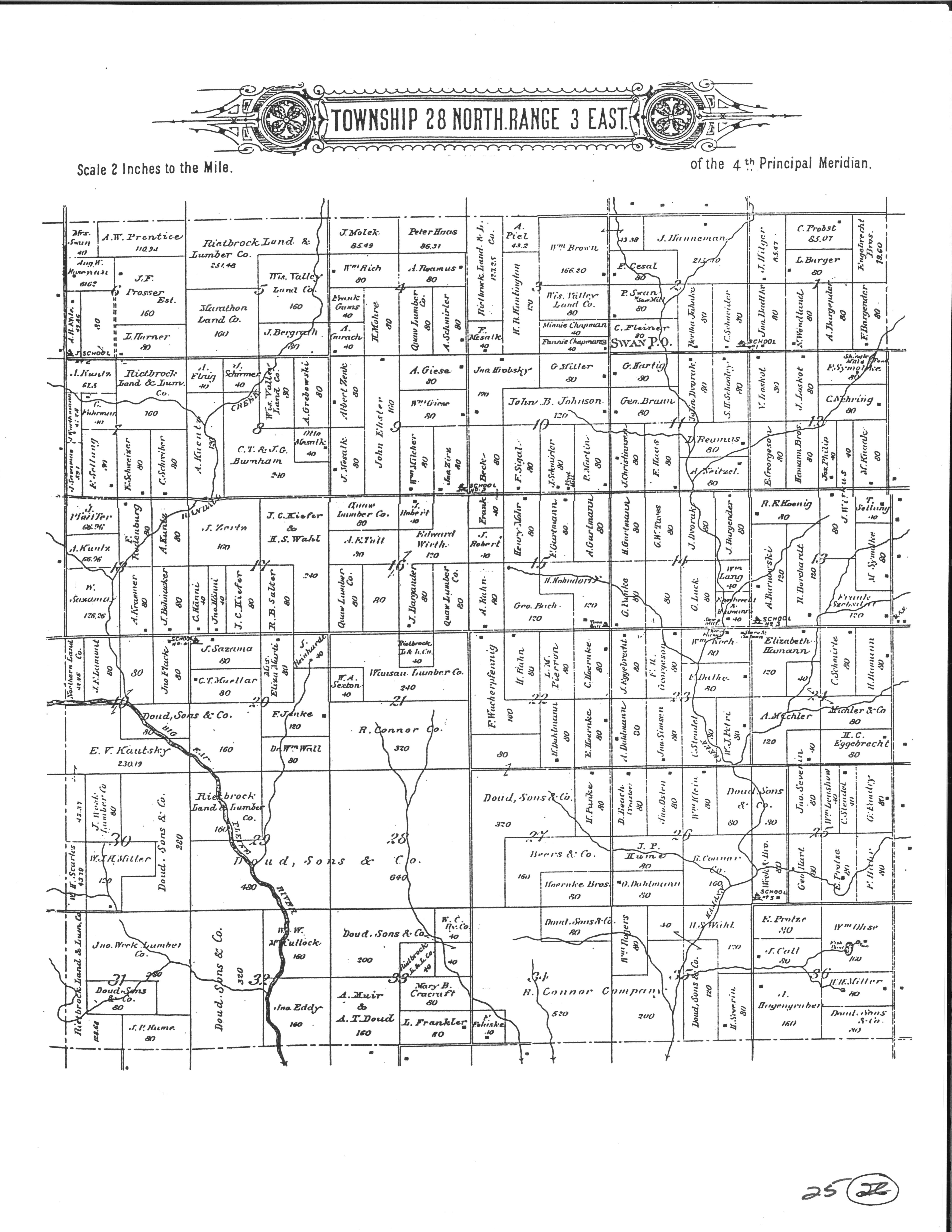Search our Places Database
Frankfort, Township of
Return To List of Locations | Back to Search
For more information on this location, please contact our research library.

Author:
Mary Moltzan
Location:
T. 28 N. - R. 3 E.
Formallized:
November 13, 1889
Background:
Population: 1905-657, 2000-651
Frankfort Township was separated from Wien Township in 1889. The first settlers were loggers who followed the rivers to move their logs, gradually moving away from water as timber was depleted.
The Wisconsin Central Railroad reached Colby in September, 1872. This caused the Town of Frankfort to be settled from the west side first. The settlement did not begin until 1877. It was slow in starting because it was 30 miles from the east boundary line to Wausau and 12 miles from the west boundary line to Colby. Fred Michler, Fred Eggebrecht and the Boehm's were the first settlers in 1877. They were followed by the Edward Protze, John Simmons and Henry Von Osten families in 1878. Other early settlers included Carl and Ernest Hoernke, Franz Jahnke, John Fandre and John Prosser.
First Public Official:
Ed Protze
Biography:
First chairman, he named the township after his hometown of Frankfort, Germany.
Post Office Established:
June 14, 1894
First Postmaster:
Joseph Schmirler
About The Post Office:
Named Swan, the P.O. was discontinued on September 30, 1902, with service from Edgar. First located in Section 10, the P.O. was later moved to the SE 1/4 of Section 3. Swan was the only P.O. ever located in the township.
Railroad:
The R. Conner Company once had a logging railroad running through part of the township. There is little trace of it today.
Churches:
1. Peace Lutheran Church - In early 1919, a group of members from St. John's American Lutheran Church in Wien Township organized Peace Lutheran Church. Within that year, the church was built, and the cornerstone was laid on June 22, 1919.
2. Catholic Church - There were few Catholic families in the area, but in the summer of 1888, 3 acres of land were sold to the LaCrosse Diosese for $1.00 and a little log church was built. No regular services were held, but church was held whenever a circuit priest came by. In 1905, the church was closed. The log church was worn down by the weather, and the graveyard stones broken and plowed under. Today no trace of the church or graveyard is to be found.
Schools:
When Frankfort was a part of the Town of Wien, youngsters no doubt attended school in the Town of Wien. The first schools had only 5 months of school but, with time, the term was extended. After the Town of Frankfort was organized, school districts were established. The districts were changed and altered as the population changed, especially the first few years. Schools at that time did not have specific names but were called common schools. When school districts were created, they tried to keep them close enough so that youngsters did not have to walk more than two miles. Many students, though, had to walk more than two miles one way to school, and frozen ears, fingers, and lunches were common during the winter months.
1. District # 1 - Smith School was a log building built about 1897 and located in Section 11. A new building was built about 1901 in Section 2.
2. #2 - The Franklin School was a frame building built in Section 9 in the late 1890s. It burned down on March 1, 1907. A temporary building was built. Then, the new school was built and opened on September 7,1908 in Section3, named after the statesman, Benjamin Franklin.
3. #3 - Hoard School in Section 13 - Fairchild and Hoard Schools were separated in 1895.
4. #4 - In Section 10 - possibly Fairchild School or Hillcrest School or Rusk Schoo
5. #5 - The Upham School, in Section 25, was built about 1917 and named after a prominent family of Marshfield.
The teachers were usually required to build fires and arrive at the school thirty minutes before school began. The preference for female teachers might be because their salaries were less. They received $25-$28 per month, a month being twenty work days. A male teacher received about $32 per month. A male teacher was sometimes needed to keep peace and order in the school house. The school population was very large for the facilities that were available. Usually forty or fifty children were in one room. One school had ninety-seven children at one time.
Industry:
Logging, sawmills and cheese factories. Cheese factories were built as early as 1888.
Farming:
In the early days, roads were few and in poor condition. Gradually as more settlers arrived, farming became more important.
Stories:
A man who attended Franklin School remembered the cows and horses coming to the windows of the school and looking in during school hours. This was probably because the area was heavily wooded at the time.
One early settler remembered he and his wife walking along and seeing something cross the road. Thinking it was a deer, they moved forward only to be confronted by a large black bear. The bear approached with its front paws in the air. Unarmed, he grabbed for a stick, but it was mired in the ground. They were helpless. All at once the bear turned and galloped away. It was joined by three or four half-grown cubs . The couple was most grateful for the hasty exit of the bear and cubs. They had heard of bears but had never seen them before. After this experience, they didn't care to see any again.



